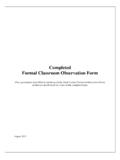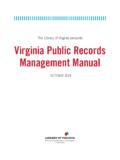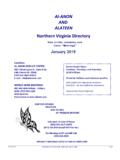Transcription of Levels of Cellular Organization - Virginia …
1 Science Enhanced Scope and Sequence Life Science Levels of Cellular Organization Strand Cellular Organization Topic Investigating patterns of Cellular Organization in living things Primary SOL The student will investigate and understand that living things show patterns of Cellular Organization . Key concepts include a) cells, tissues, organs, and systems; and b) patterns of Cellular Organization and their relationship to life processes in living things. Related SOL The student will investigate and understand that all living things are composed of cells. Key concepts include a) cell structure and organelles.
2 Background Information Each organism is made up of cells, tissues, organs, and organ systems. In order for a complex organism to survive, its various Levels must function smoothly and work together. Whether multicellular or unicellular, an organism's structures must perform specific functions to maintain stable life conditions. Materials Heavy white paper to create foldables Crayons, colored pencils, markers Textbook transparencies, Internet/ library resources for example illustrations Graphic organizer/foldable sample to present to class Vocabulary arrangement, cell, Cellular Organization , complex, function, multicellular, organ, organ system, organism, process, relationships, specialized, stable, tissue, unicellular Student/Teacher Actions (what students and teachers should be doing to facilitate learning).
3 1. Distribute a sheet of heavy white paper to each student. Have students fold the papers in half vertically and use pencils to draw lines dividing the hot dog style folded paper into four equal boxes. 2. Direct students to label the four boxes (or doors), from top to bottom, Cells, Tissues, . Organs, and Organ Systems. These doors could also be used to illustrate the Cells four Levels . The exterior of the paper should now look like the diagram at right. Tissues When the doors are opened flat, the interior will expose two columns for listing Organs detailed information. Possible content is listed on the attached Sample Foldable Template and Content, but it may be modified as desired.
4 Organ Systems 3. Place students in small groups, and encourage each group to fill in their own Virginia department of education 2012 1. Science Enhanced Scope and Sequence Life Science important facts based on text information, Internet research (if available), or library resources. Have groups share facts with the class to make a collaborative detailed chart of information. Display this list in the classroom until formal assessment. Assessment Questions o Why do organisms require different Levels of Cellular Organization ? o What are the four Levels of Organization ? o Do unicellular organisms have Levels of Organization ?
5 Explain your answer. Journal/Writing Prompts o Explain how Cellular Organization compares to the Organization of topics in a textbook. o List examples of organisms that contain cells, tissues, organs and organ systems. Other o Describe the structures required for one human body organ system. Extensions and Connections (for all students). Have students create a board game to play in class. Students will develop a game board, question cards with answers, game pieces and playing instructions. Teachers can bring in common board games to use as examples and provide poster board for each group to begin.
6 These games could be saved and reused later in the year as review. To complete SOL content, students could add question cards relating to osmosis, diffusion, and other life processes as a culminating project. Strategies for Differentiation Have a created set of defined information to be included inside the foldable. If student knowledge is affirmed, allow students to sort and list information in the appropriate sequence. Virginia department of education 2012 2. Science Enhanced Scope and Sequence Life Science Sample Foldable Template and Content Name: Date: Cell: basic unit of structure and function in a The cell is the smallest unit of Cellular living thing Organization .
7 Complex organisms are composed of MANY The human body consists of approximately 100. cells. trillion cells. _____ _____. Tissue: a group of similar cells that perform the Tissue is the next largest level of Organization . same function _____. _____. Organ: a structure composed of different types Examples of organs in the human body include of tissues the heart, the brain, the lungs, and the _____ stomach. _____. Organ System: Each organ within the human Organ systems are the largest level of Cellular body is part of an organ system. Organization . _____ The human body contains 11 organ systems, including skin, skeletal, nervous, respiratory, and digestive.
8 _____. Virginia department of education 2012 3.














